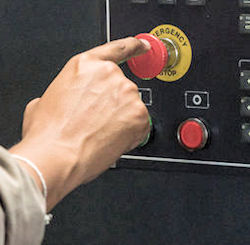Employees Who May Remain to Shut Down
Large companies may have certain equipment and processes that must be shut down in stages or over time. In other instances, it is not possible or practical for employees to stay behind to shut down equipment or processes under emergency situations and everyone must evacuate.
However, smaller enterprises may require designated employees to remain behind briefly to operate fire extinguishers or shut down gas and/or electrical systems and other special equipment that could be damaged if left operating or create additional hazards to emergency responders (such as releasing hazardous materials).
Each employer must review their operation and determine whether total and immediate evacuation is possible for various types of emergencies. The preferred approach, and the one most often taken by small enterprises, is immediate evacuation of all their employees when the evacuation alarm is sounded.
If any employees will stay behind, the plan must describe in detail the procedures to be followed by these employees.
- All employees remaining behind must be capable of recognizing when to abandon the operation or task and evacuate themselves before their egress path is blocked.
- In small establishments it is common to include in the plan locations where utilities (such as electrical and gas) can be shut down for all or part of the facility either by company employees or by emergency response personnel.
Knowledge Check Choose the best answer for the question.
1-7. Why are some employees designated to stay behind and not evacuate immediately when an emergency occurs?
You forgot to answer the question!

